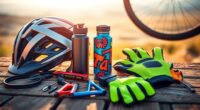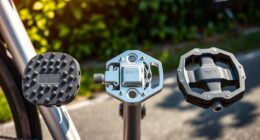To fuel your ride, prioritize hydration and proper carbohydrate intake. Aim for 1 liter of fluids for every 2 pounds lost, and consume 30-60 grams of carbohydrates per hour during high-intensity efforts. For rides over three hours, increase your intake to 60-90 grams. Pair water with electrolyte drinks for long rides, and refuel with a 3:1 ratio of carbs to protein within an hour after you finish. There's so much more to discover about optimizing your cycling nutrition.
Key Takeaways
- Stay hydrated by drinking 1 liter of fluids for every 2 pounds of body weight lost during rides.
- For high-intensity rides, consume 30-60 grams of carbohydrates per hour to maintain energy levels.
- Integrate electrolyte drinks on rides over 90 minutes to sustain sodium balance and prevent fatigue.
- Plan nutrition intake in advance and keep energy gels or bars easily accessible during longer rides.
- Prioritize a post-ride meal with a 3:1 ratio of carbohydrates to protein within 60 minutes for optimal recovery.
The Importance of Hydration in Cycling Nutrition
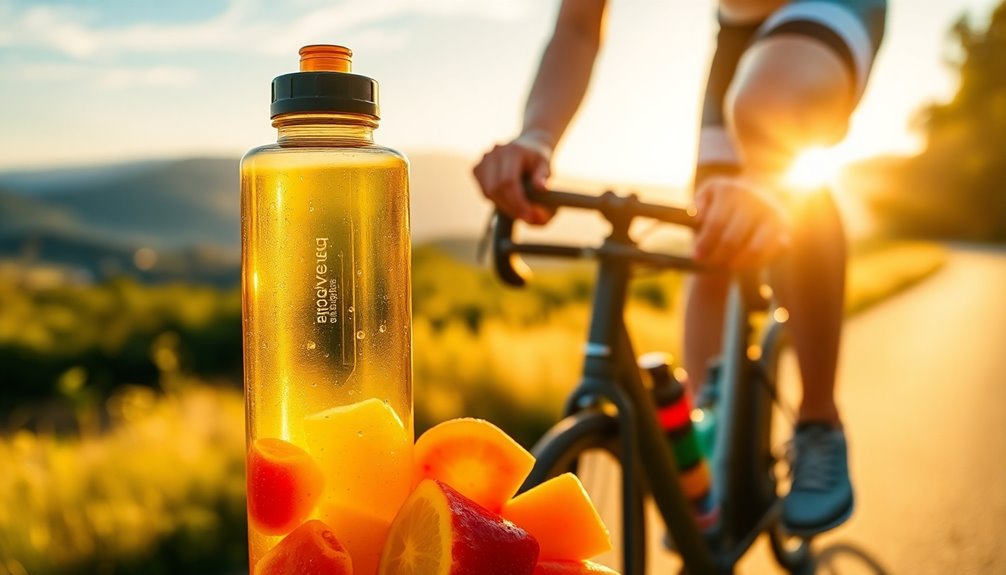
When you're out on a long ride, staying hydrated isn't just important; it's essential for maintaining peak performance.
To meet your hydration needs, you should drink enough fluids to replace lost body weight—aim for about 1 liter for every 2 pounds you lose. If your ride exceeds 90 minutes, incorporating electrolyte drinks is critical to maintain sodium levels and prevent cramps and dehydration.
In hot conditions, your hydration needs increase, so it's imperative to monitor hydration levels consistently. Developing a personal hydration plan based on ride duration, intensity, and environmental conditions will help guarantee ideal fluid balance.
Carbohydrate Intake: Fueling High-Intensity Rides
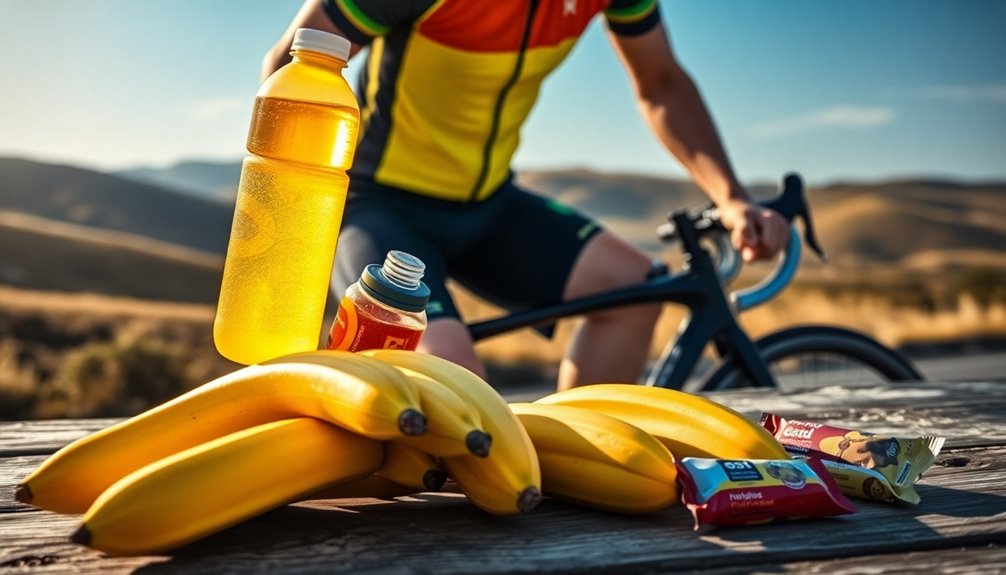
To maximize your performance during high-intensity rides, it's vital to focus on carbohydrate intake. Aim to consume 30-60 grams of carbohydrates per hour to maintain peak performance and prevent fatigue.
If your ride exceeds three hours, increase your intake to 60-90 grams per hour to effectively replenish glycogen stores.
Combining different carbohydrate sources, like glucose and fructose, can enhance energy availability by 20-50%, which is significant during intense efforts.
Combining glucose and fructose boosts energy availability by 20-50%, crucial for maximizing performance during intense rides.
Opt for easily digestible energy gels to deliver rapid energy without gastrointestinal distress.
This approach not only fuels your muscles but also helps you stay strong throughout your ride, ensuring you can push harder and longer while keeping fatigue at bay.
Nutrition Strategies for Different Ride Lengths

Understanding how to fuel your body for rides of varying lengths can greatly enhance your cycling experience and performance.
For short rides lasting up to 60-75 minutes, focus on hydration with plain water, as you can rely on stored energy without consuming calories.
During medium rides of 1-3 hours, consume 20-30% of your energy expenditure, aiming for 20-60 grams of carbohydrates per hour from solid foods and simple sugars.
For long rides of 3-6 hours, combine water, electrolyte, and carbohydrate drinks, increasing intake to 30-60 grams of carbohydrates per hour.
On extra-long rides, maintain hydration while opting for easily digestible foods.
Finally, don't forget a balanced recovery meal within 60 minutes post-ride to replenish glycogen stores effectively.
Practical Tips for Managing Nutrition During Rides
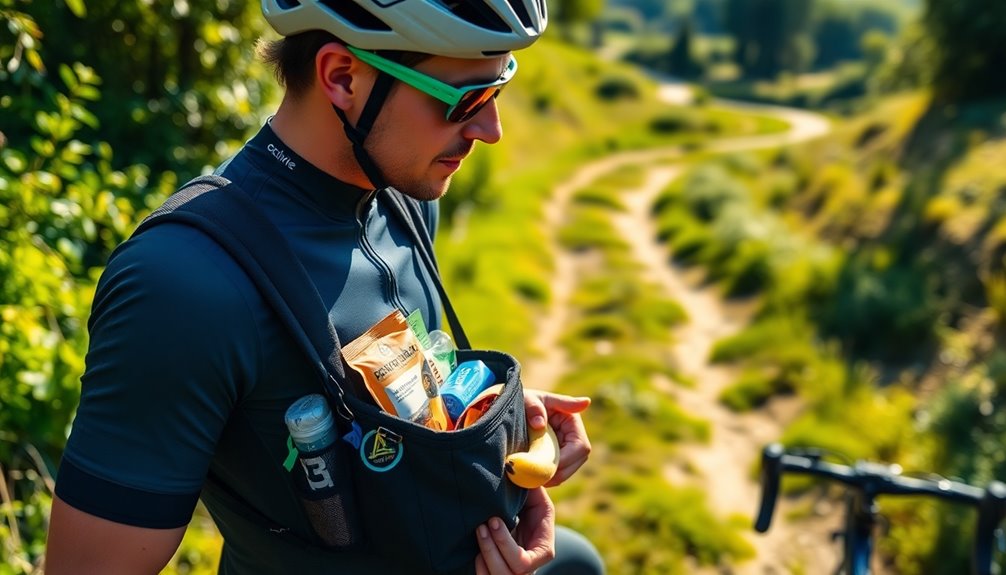
Managing your nutrition during rides can greatly impact your performance and enjoyment. To optimize your energy expenditure, plan your nutrition intake in advance. Break rides into sections with feeding times to keep you motivated.
Here are some practical tips:
- Aim for 20-30% of your energy expenditure in calories from a mix of solid foods and easy-to-digest carbohydrates.
- For long rides, combine hydration with water and electrolyte drinks to prevent gut overload.
- Keep nutrition options like gels, bars, and snacks easily accessible in your gear.
Practice your nutrition strategy during training, so you know what works for you. This way, you can effectively manage nutrition and fuel your rides without surprises on race day.
Post-Ride Nutrition for Optimal Recovery
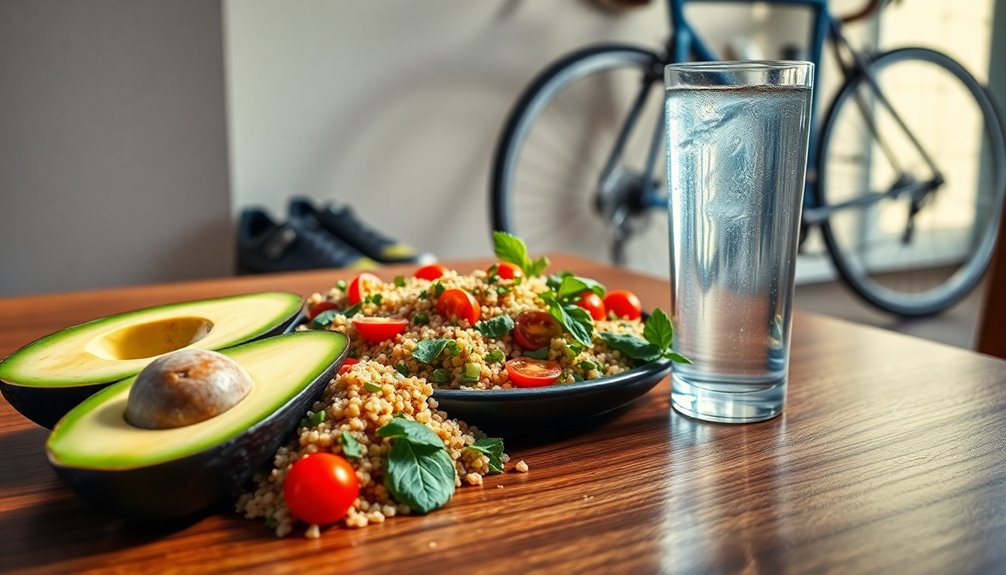
After a rewarding ride, your body needs the right fuel to recover and replenish. Focus on consuming a carbohydrate-rich meal or shake within 20–60 minutes post-ride to efficiently restore glycogen levels.
After cycling, prioritize a carbohydrate-rich meal or shake within 20–60 minutes to restore glycogen levels effectively.
Aim for a 3:1 ratio of carbohydrates to protein, targeting 1-1.2 grams of carbohydrates per kilogram of your body weight to enhance muscle repair.
Prioritize real food options like fruits, whole grains, and lean proteins for ideal post-ride nutrition.
Don't forget hydration; replace fluids lost during cycling by drinking about 1 liter of water for every 2 pounds lost.
Frequently Asked Questions
How to Properly Fuel for Cycling?
To properly fuel for cycling, you need to focus on your hydration and carbohydrate intake.
For rides under an hour, stick to plain water. For medium rides, aim for 30-60 grams of carbohydrates per hour. On long rides, increase that to 60-90 grams, along with electrolytes.
After your ride, eat a balanced meal with carbs, protein, and fats within an hour.
Always practice your fueling strategy during training to see what works best for you.
What Is the 75 Rule in Cycling?
You'd think riding a bike is just about pedaling, right? But that's not the whole picture.
The 75 Rule in cycling states you should get 75% of your calories from carbohydrates during long rides. This helps maintain your energy and prevents those dreaded glycogen crashes.
For rides over 90 minutes, aim for 30-60 grams of carbs per hour. Planning your nutrition wisely can keep you powered up and ready to tackle any distance!
What Is the Best Source of Fuel for Cycling?
When you're looking for the best source of fuel, carbohydrates are your go-to. They provide the quick energy needed for high-intensity activities.
Energy gels work great for fast absorption, while real foods like bananas and energy bars offer longer-lasting fuel. For extended sessions, aim for 60-90 grams of carbs per hour.
Mixing different carb types can enhance absorption, keeping your energy steady and your performance strong.
How to Fuel Endurance Rides?
How do you keep your energy up during those long rides?
For endurance rides over three hours, aim to consume 60-90 grams of carbohydrates each hour.
Stay hydrated with water and electrolytes, about one bottle per hour.
Start refueling early—don't wait for hunger—target 30-60 grams of carbs hourly.
Vary your snacks to keep it interesting, and remember to eat a balanced meal with carbs and protein soon after your ride for ideal recovery.
Conclusion
In summary, fueling your rides effectively can make a huge difference in your performance. Did you know that cyclists can burn up to 1,000 calories per hour during intense rides? That's why proper hydration and carbohydrate intake are essential. By following the nutrition strategies we've discussed, you'll be better equipped to tackle any distance and recover faster afterward. So, pay attention to what you eat and drink, and watch your cycling game elevate!

